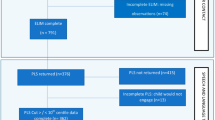Abstract
The goal of early language intervention is to teach children the community language resulting in a functional communication system. This enterprise presumes the early identification of children at risk for impaired communication development and strategies that sustain facilitation of language acquisition when initiated early in life.
Access this chapter
Tax calculation will be finalised at checkout
Purchases are for personal use only
Preview
Unable to display preview. Download preview PDF.
Similar content being viewed by others
References
Bricker, D. Imitative sign training as a facilitator of word-object association with low-functioning children. Am. J. Ment. Defic., 76:509–516 (1972).
Bricker, D. and Carlson, L. Issues in Early Language Intervention. Paper presented at the conference entitled “Early Language Intervention,” Sturbridge, Massachusetts, May (1979).
Bricker, D., Seibert, J. and Scott, K. Early Intervention: History, Current Status and the Problem of Evaluation. Paper presented at Gatlinburg Conference on Mental Retardation Research, March (1978).
Bricker, W. and Bricker, D. Behavior modification programmes, in Mittler, P. (ed.), Assessment for Learning in the Mentally Handicapped. London: Churchill Livingstone (1973).
Bricker, W. and Bricker, D. An early language training strategy, in Schiefelbusch, R.L. and Lloyd, L.L. (eds.), Language Perspectives-Acquisition, Retardation and Intervention. Baltimore: University Park Press, pp. 431–468 (1974).
Bronfenbrenner, U. Is early intervention effective? in Guttentag, M. and Struening, E. (eds.), Handbook of Evaluation Research, Vol. 2. Beverly Hills, California: Sage Publications (1975).
Chapman, R. Mother-Child Interaction in the Second Year of Life: Its Role in Language Development. Paper presented at the conference entitled “Early Language Intervention,” Sturbridge, Massachusetts, May (1979).
Farran, D. and Ramey, C. Social Class Differences in Dyadic Involvement During Infancy. Paper submitted for publication (1979).
Fowler, W. A Strategy for Infant Learning and Developmental Learning. Paper presented at the conference entitled “Early Language Intervention,” Sturbridge, Massachusetts, May (1979).
Fristoe, MaCalyne. Language Intervention Systems: Programs Published in Kit Form, in Lloyd, L. (ed.), Communication Assessment and Intervention Strategies. Baltimore: University Park Press (1972).
Graham, L. Language programming and intervention, in Lloyd, L. (ed.), Communication Assessment and Intervention Strategies. Baltimore: University Park Press, pp. 371–422 (1976).
Guess, D., Sailor, W. and Baer, D. A behavioral-remedial approach to language training for the severely handicapped, in Sontag, E. (ed.), Educational Programming for the Severely Handicapped. Reston, Va.: CEC (1977).
Hart, B. and Rogers-Warren, A. A milieu approach to teaching language, in Schiefelbusch, R. (ed.), Language Intervention Strategies. Baltimore: University Park Press, pp. 193–236 (1978).
Haskins, R., Finkelstein, N. and Stedman, D. Infant-stimulation programs and their effects. Pediat. Ann., 7:2,123–144 (1978).
Heber, R. and Garber, H. The Milwaukee Project: A study of the use of family intervention to prevent cultural-familial retardation, in Friedlander, B., Sterritt, G. and Kirk, S. (eds.), Exceptional Infant, Vol. 1. New York: Brunner/Mazel (1975).
Kysela, G., Hillyard, A., McDonald, L. and Ahlsten-Taylor. Early Intervention: Design and Evaluation. Paper presented at the conference entitled “Early Language Intervention,” Sturbridge, Massachusetts, May (1979).
McDonald, J. and Blott, J. Environmental language intervention: The rationale for a diagnostic and training strategy through rules, context and generalization. J. Speech and Hear. Disord., 39:244–256 (1974).
Miller, J. and Yoder, D. On developing the content for a language teaching program. Ment. Retard., 10:9–11 (1972a).
Miller, J. and Yoder, D. A syntax teaching program, in McLean, J., Yoder, D. and Schiefelbusch, R. (eds.), Language Intervention with the Retarded: Developing Strategies. Baltimore: University Park Press, pp. 191–211 (1972b).
Miller, J. and Yoder, D. An ontogenetic teaching strategy for retarded children, in Schiefelbuscli, R. and Lloyd, L. (eds.), Language Perspectives-Acquisition, Retardation and Intervention. Baltimore: University Park Press (1974).
Ramey, C, Collier, A., Sparlmg, J., Loda, R., Campbell, F., Ingram, D. and Finkelstein, N. The Carolma Abecedarian Project: A longitudinal and multidisciplinary approach to the prevention of developmental retardation, in Tjossem, T. (ed.), Intervention Strategies for High-Risk Infants and Young Children. Bahimore: University Park Press, pp. 629–665 (1976).
Ramey, C. and Smith, B, Assessing the intellectual consequences of early intervention with high-risk infants. Am. J. Ment. Defic, 81:318–324 (1977).
Ramey, C., Sparling, J. and Wasik, B. Creating Social Environments to Facilitate Language Development. Paper presented at the conference entitled “Early Language Intervention,” Sturbridge, Massachusetts, May (1979).
Ramey, C., Stedman, D., Borders-Patterson, A. and Mengel, W. Predicting school failure from information available at birth. Am. J. Ment. Defic, 82:525–534 (1978).
Robinson, H. and Robinson, N. Longitudinal development of very young children in a comprehensive day-care program: The first two years. Child Devel, 42:1673–1683 (1971).
Stokes, T. and Baer, D. An implicit technology of generalization. J. Appl Behav. Anal, 10:349–367 (1977).
Thoman, E. Non-Linguistic Communication as the Prelude and Context for Language Learning. Paper presented at the conference entitled “Early Language Intervention,” Sturbridge, Massachusetts, May (1979).
Editor information
Editors and Affiliations
Rights and permissions
Copyright information
© 1981 Spectrum Publications, Inc.
About this chapter
Cite this chapter
Miller, J.F. (1981). Early Language Intervention: When and How. In: Lewis, M., Taft, L.T. (eds) Developmental Disabilities. Springer, Dordrecht. https://doi.org/10.1007/978-94-011-6314-9_20
Download citation
DOI: https://doi.org/10.1007/978-94-011-6314-9_20
Publisher Name: Springer, Dordrecht
Print ISBN: 978-94-011-6316-3
Online ISBN: 978-94-011-6314-9
eBook Packages: Springer Book Archive




